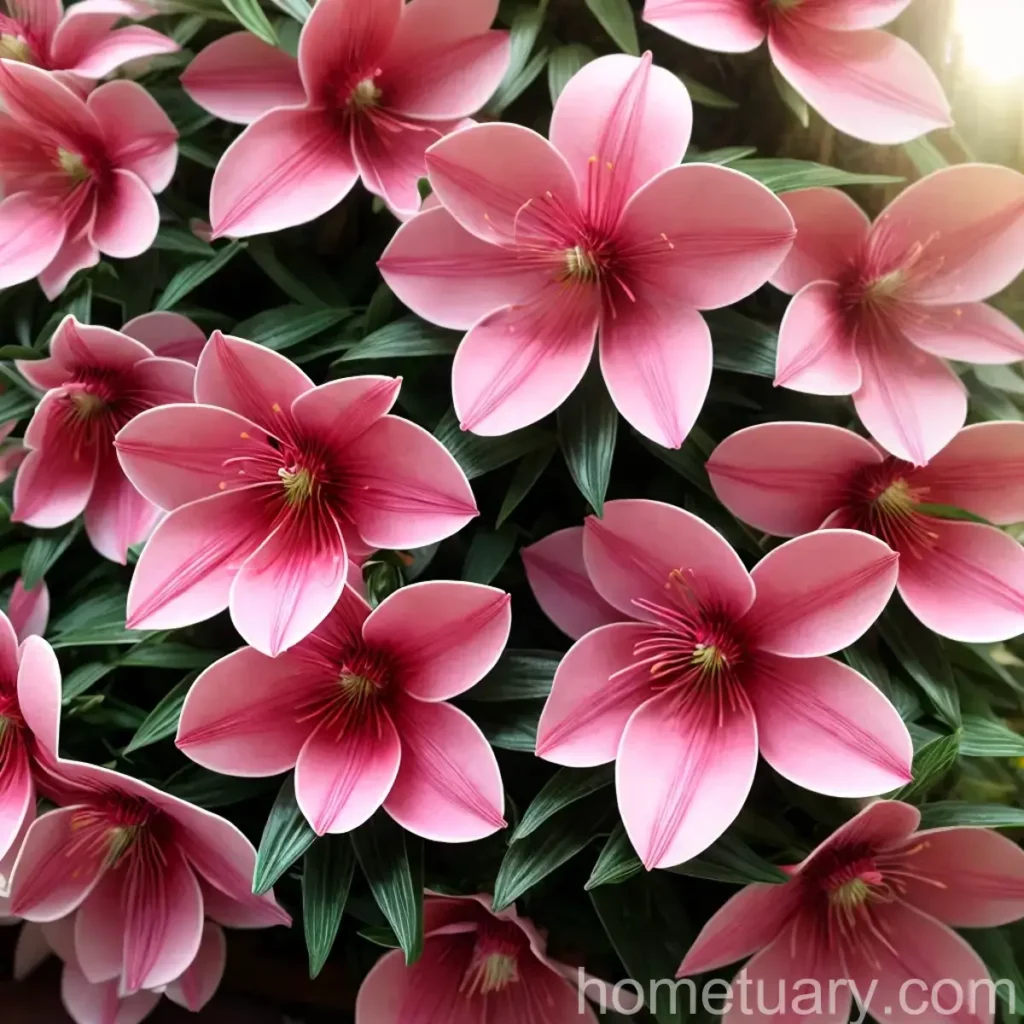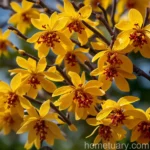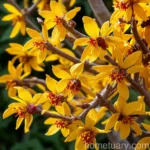Chinese Fringe-Flower (Loropetalum chinense ‘Rubrum’): A Comprehensive Guide
What is Chinese Fringe-Flower (Loropetalum chinense ‘Rubrum’)?
Chinese fringe-flower, scientifically known as Loropetalum chinense ‘Rubrum’, is a versatile and visually striking evergreen shrub that belongs to the witch-hazel family, Hamamelidaceae. It is native to the woodlands and rocky slopes of China, Japan, and Southeast Asia. The name “fringe-flower” is derived from the unique fringed or spidery flowers that the plant bears.
This plant is popular for its vibrant, ornamental foliage and eye-catching flowers, making it a favorite among gardeners and landscape enthusiasts. Chinese fringe-flower is cherished for its ability to thrive in various climates and soil types, its low maintenance requirements, and its year-round visual interest.
Key Takeaways – Chinese Fringe-Flower (Loropetalum chinense ‘Rubrum’)
- Genus and Species: Loropetalum chinense ‘Rubrum’
- Common Name: Chinese Fringe-Flower
- Family: Hamamelidaceae
- Type: Evergreen shrub
- Native Habitat: China, Japan, and Southeast Asia
- Notable Features: Fringed flowers, vibrant foliage
- Uses: Ornamental landscaping, hedges, containers, borders
- Hardiness Zones: 7-10
- Water Needs: Moderate
- Sunlight Requirements: Full sun to partial shade
- Mature Size: 6-10 feet in height and width
- Blooms: Spring and sporadically throughout the year
- Foliage Color: Purple to burgundy
- Soil Preferences: Well-draining, slightly acidic soil
- Disease Resistance: Generally resistant, especially in optimal growing conditions
- Pest Susceptibility: Minimal, except for aphids and spider mites
Now, let’s delve into the intricate care, cultivation, and characteristics of the Chinese fringe-flower, Loropetalum chinense ‘Rubrum’.
Culture
The culture of Chinese fringe-flower involves providing the ideal growing conditions to ensure optimal health, vigor, and aesthetics. This includes attending to its water, sunlight, fertilizer, soil, and pruning needs.
Uses
Chinese fringe-flower, with its striking foliage and colorful blooms, is a versatile and visually appealing addition to gardens and landscapes. It serves various purposes, including:
- Ornamental Landscaping: Adds a pop of color and visual interest to gardens, borders, and naturalized areas.
- Hedges and Screens: Can be used to create informal hedges and screens to delineate spaces or provide privacy.
- Container Gardens: Thrives in containers, making it suitable for patios, decks, and small urban spaces.
- Accent and Focal Points: Stands out in mixed borders and as a standalone focal point in the landscape.
Water
Chinese fringe-flower exhibits moderate water needs. It is essential to maintain consistent moisture levels in the soil, especially during its establishment phase and periods of drought. However, it is crucial to avoid waterlogging, which can lead to root rot and other moisture-related issues.
When watering, it is beneficial to aim for deep, thorough soakings rather than frequent, shallow watering. This encourages the development of a robust root system and promotes overall plant health. Mulching around the base of the plant helps to retain soil moisture and regulate temperature, further aiding in water conservation.
Sunlight
In terms of sunlight requirements, Chinese fringe-flower thrives in full sun to partial shade. While it can adapt to different light conditions, it tends to display the most vibrant foliage and prolific flowering in full sun. In regions with intense summer heat, providing some afternoon shade can help prevent leaf scorch and maintain the plant’s overall health.
Striking a balance between sunlight and shade is crucial for ensuring the best performance and aesthetic appeal of Loropetalum chinense ‘Rubrum’. Observing the plant’s response to its current lighting conditions can offer valuable insights into whether adjustments are necessary.
Fertilizer
Fertilizing Chinese fringe-flower can contribute to robust growth, abundant blooms, and vibrant foliage. During the growing season, applying a balanced, slow-release fertilizer specifically formulated for shrubs and flowering plants can provide the necessary nutrients for healthy development.
It is advisable to fertilize Chinese fringe-flower in early spring, just before the growing season begins. Additionally, a light application in mid-summer may help sustain its vigor and flowering potential. Care should be taken to follow the manufacturer’s recommendations regarding application rates and methods to prevent overfertilization, which can be detrimental to the plant.
Soil
Chinese fringe-flower thrives in well-draining, slightly acidic soil. A loamy soil with good organic content is ideal for promoting healthy growth and blooming. If the soil is compacted or prone to waterlogging, incorporating organic matter such as compost or peat moss can improve its structure and drainage capabilities.
It is essential to perform a soil test to assess the pH level and nutrient composition of the planting site. This allows for targeted amendments based on the specific needs of Loropetalum chinense ‘Rubrum’. Most importantly, avoiding heavy, clayey soils and highly alkaline conditions is crucial for the plant’s long-term well-being.
Pruning
Pruning is an essential aspect of Chinese fringe-flower care, contributing to its overall shape, size, and flowering potential. Proper pruning techniques not only enhance the plant’s aesthetics but also promote air circulation, reduce disease risk, and encourage new growth.
Pruning Techniques
When it comes to pruning Chinese fringe-flower, a combination of maintenance pruning and selective shaping is beneficial. The following techniques can be employed to achieve the desired form and promote healthy growth:
- Routine Maintenance: Regularly remove dead, damaged, or diseased branches and spent flowers throughout the growing season.
- Selective Pruning: Conduct selective pruning to maintain the desired size and shape. Focus on trimming back excessively long or straggly shoots to encourage bushier growth and a more compact form.
- Rejuvenation Pruning: Perform rejuvenation pruning, if needed, by cutting back overgrown or neglected plants to a height of about one-third. This can revitalize the plant and stimulate fresh, vigorous growth.
Pruning Chinese fringe-flower immediately after the spring bloom cycle is advisable, as it allows the plant to recover and produce new growth for the following season. It is essential to use clean, sharp pruning tools to make precise cuts and minimize the risk of injury to the plant.
Propagation
Propagating Chinese fringe-flower allows for the expansion of its presence in the landscape and provides an opportunity to share its beauty with others. The plant can be propagated through various methods, including cuttings, layering, and seed propagation.
Cuttings
Propagation from cuttings is a popular and reliable method for reproducing Loropetalum chinense ‘Rubrum’. Here’s a basic outline of the steps involved in propagating the plant from cuttings:
- Selection: Choose a healthy, non-flowering stem from the parent plant, ideally in the early summer.
- Preparation: Cut a 4-6 inch segment of the stem just below a leaf node, utilizing sterilized pruning shears.
- Treatment: Remove the lower leaves to expose the nodes and dip the cut end in a rooting hormone powder to encourage root development.
- Planting: Insert the cutting into a pot filled with a well-draining rooting medium, ensuring that at least two nodes are buried.
- Environment: Place the pot in a warm, humid environment with bright, indirect light, and maintain consistent moisture levels.
- Rooting: Roots should begin to develop within 4-6 weeks, at which point the cutting can be transplanted into a larger container or directly into the garden.
Understanding the proper timing, environmental conditions, and care requirements for cuttings is crucial for successful propagation. Patience and attentive monitoring are key during the rooting phase.
Layering
Layering is another propagation method that can be employed to produce new Chinese fringe-flower plants. This process involves encouraging the development of roots on a stem while it is still attached to the parent plant.
- Selection: Identify a flexible, healthy stem on the parent plant and make a shallow 4-6 inch incision or wound on the underside.
- Treatment: Apply a rooting hormone to the wounded area to stimulate root initiation.
- Covering: Bury the wounded portion of the stem in a small hole filled with a rooting medium, such as a mixture of peat moss and perlite.
- Stabilization: Secure the buried portion with a U-shaped stake or a heavy object to maintain contact with the soil.
- Rooting: Roots should begin to form over several months, at which point the new plant can be separated from the parent and transplanted to its desired location.
Layering is a slower method of propagation compared to cuttings but can be an effective way to produce genetically identical plants with minimal equipment and effort.
Seed Propagation
While feasible, seed propagation of Chinese fringe-flower is less common due to the variability in seed germination and potential differences in the characteristics of the resulting plants. Nevertheless, for those interested in seed propagation, the following steps can be considered:
- Collection: Harvest mature seeds from the plant during the late summer or early fall when the seed capsules have ripened and begun to split.
- Preparation: Clean the seeds by removing any remaining pulp or debris, and then air-dry them for a few days to prevent fungal growth.
- Sowing: Plant the seeds in a well-draining seed-starting mix in small containers or trays, ensuring consistent moisture and warmth for germination.
- Germination: Keep the seeds consistently moist and maintain temperatures around 70-75°F to encourage germination, which can take anywhere from a few weeks to several months.
- Transplanting: Once the seedlings have developed several sets of true leaves, they can be transplanted into individual containers or directly into the garden.
Seed propagation may result in slight variations in the appearance and characteristics of the new plants. As a result, it is often used for breeding purposes rather than mass production of identical specimens.
Container Popularity
Chinese fringe-flower’s adaptability to container cultivation makes it a popular choice for various urban and suburban settings. Its vibrant foliage and beautiful blooms add visual interest to patios, balconies, and other outdoor living spaces. Additionally, its container-friendly nature allows it to thrive in areas with limited garden space or where soil conditions may not be ideal for in-ground planting.
When selecting a container for Chinese fringe-flower, opt for one with adequate drainage holes to prevent waterlogging and root rot. Using a lightweight, well-draining potting mix specifically formulated for container plants is crucial for the plant’s overall health and success. Proper watering and regular fertilization are essential considerations when growing Chinese fringe-flower in containers, as the limited soil volume can lead to rapid fluctuations in moisture and nutrient levels.
Common Diseases
Chinese fringe-flower, particularly Loropetalum chinense ‘Rubrum’, is generally hardy and resistant to most common plant diseases. However, it can be susceptible to certain issues under unfavorable growing conditions or when proper care is neglected.
Disease Diagnosis
Some of the potential diseases that may affect Chinese fringe-flower include:
- Powdery Mildew: Characterized by a white, powdery growth on the leaves, powdery mildew can hinder photosynthesis and weaken the plant over time.
- Root Rot: Caused by overwatering or poorly draining soil, root rot can lead to wilting, yellowing foliage, and deterioration of the plant’s root system.
- Leaf Spot: Visible as dark, irregular spots on the foliage, leaf spot diseases can result from environmental stress or fungal pathogens, leading to premature leaf drop and reduced vigor.
- Cankers: Cankers are localized areas of dead tissue on the stems or branches, often caused by injury, disease, or unfavorable growing conditions.
Diagnosing and addressing potential diseases promptly is crucial for preventing the further spread of the condition and preserving the plant’s health. Implementing cultural practices that promote good air circulation, proper watering, and soil maintenance can significantly reduce the risk of disease development.
Common Pests
While Chinese fringe-flower is relatively resistant to major pest infestations, it can occasionally encounter issues with certain insects and mites.
Some common pests that may affect Chinese fringe-flower include:
- Aphids: These small, soft-bodied insects feed on the plant’s sap, causing distorted growth, yellowing leaves, and the secretion of sticky honeydew.
- Spider Mites: These minuscule pests often thrive in hot, dry conditions, causing stippling, webbing, and overall decline in plant health.
- Scale Insects: Scale insects can attach themselves to stems and leaves, feeding on plant fluids and potentially causing wilting and yellowing.
Vigilant monitoring of the plant for signs of pest activity, particularly on the undersides of leaves and along stems, can aid in early detection and prompt intervention. In cases of minor infestations, physical removal of pests and the use of insecticidal soaps or horticultural oils can help manage the issue effectively.
Botanist’s Tips
As a botanist passionate about Chinese fringe-flower and its intricate care, here are some additional tips to ensure the optimal growth and flourishing of Loropetalum chinense ‘Rubrum’:
- Mulching: Apply a 2-3 inch layer of organic mulch around the base of the plant to conserve moisture, regulate soil temperature, and discourage weed growth.
- Winter Protection: In regions with harsh winters, consider providing protection to Chinese fringe-flower by mulching around the base and wrapping the plant with burlap if prolonged freezing temperatures are expected.
- Regular Inspection: Periodically inspect the plant for any signs of stress, disease, or pest activity, and take necessary actions to address issues promptly.
- Companion Planting: Pair Chinese fringe-flower with complementary plants such as ornamental grasses, flowering perennials, and other shrubs to create visually appealing and ecologically beneficial landscapes.
- Wildlife Habitat: Recognize the plant’s potential to attract pollinators, such as butterflies and bees, contributing to the overall biodiversity and ecological balance in the garden.
Fun Facts
As we explore the captivating world of Chinese fringe-flower, here are some intriguing and delightful facts about Loropetalum chinense ‘Rubrum’:
- Plant Origin: The species name “chinense” denotes its Chinese origin, while the cultivar name “Rubrum” refers to the vibrant red coloration of its foliage and flowers.
- Cultural Significance: In Chinese folklore, the fringe-flower is associated with courage and resilience, symbolizing strength and determination in the face of adversity.
- Longevity: When provided with proper care and growing conditions, Chinese fringe-flower can thrive for many years, gracing the landscape with its beauty and charm.
- Seasonal Changes: While Chinese fringe-flower is renowned for its striking appearance in the spring, it also undergoes subtle foliage changes in response to seasonal shifts, adding dynamic visual interest to the garden throughout the year.
Links to External Resources
For further exploration of Chinese fringe-flower and Loropetalum chinense ‘Rubrum’, the following external resources provide valuable insights, guidance, and inspiration:
- The American Horticultural Society’s A-Z Encyclopedia of Garden Plants – A comprehensive reference for plant enthusiasts, with detailed information on the cultivation and care of ornamental plants including Loropetalum chinense.
- Royal Horticultural Society’s Plant Finder – An extensive database and plant finder tool, offering an array of cultivars, species, and gardening advice, catering to both amateur and experienced gardeners.
- University Extension Services – Access resources from various state university extension services, including horticulture fact sheets, gardening guides, and plant care recommendations specific to different regions.
In conclusion, Chinese fringe-flower, Loropetalum chinense ‘Rubrum’, stands as a captivating and resilient addition to gardens, landscapes, and urban green spaces. Its vibrant foliage, alluring blooms, and adaptability make it an exquisite choice for those seeking to enhance their outdoor environments with a touch of elegance and charm. By understanding and embracing its unique characteristics and care requirements, enthusiasts can unlock the full potential of this remarkable plant, creating visually captivating and ecologically beneficial outdoor spaces.
Plant Name: “Chinese fringe-flower (Loropetalum chinense ‘Rubrum’)”
References
- American Horticultural Society. (2008). A-Z Encyclopedia of Garden Plants. DK.
- Royal Horticultural Society. (n.d.). Plant Finder. https://www.rhs.org.uk/plants
- University Extension Services. (n.d.). https://www.extension.org/
- J. Speirs, P. McMillan. (2008). CFE – Chinese fringe flower (Loropetalum chinense ‘Rubrum’)















